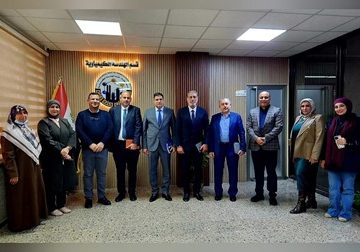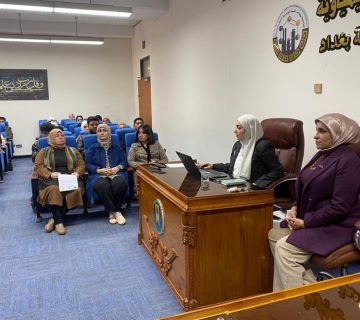The Chemical Engineering Department at the College of Engineering, University of Baghdad, held an MSc thesis examination titled:
“ Non-Thermal Plasma Technology for Oxidative Desulfurization of Model Fuel and Heavy Naphtha“
By the student Noor Mohammed Abdullah and supervised by Prof. Dr. Hussien Qasim. Hussien and Dr. Rana Rasool Jalil.
The examination committee consisted of Prof. Dr. Ammar Salih Abbas as Chairman and the membership of Assist. Prof. Dr. Zainab Talib Al-Sharify and Assist. Prof. Dr. Rana Thabet Abd Alrubaye. After conducting the public discussion and listening to the student’s defense, the thesis was accepted. The thesis was summarized as follows:
hydrocarbon processing is currently focused on removing sulfur compounds from various petroleum fractions, as sulfur is the most significant contamination present in petroleum fractions, where it occurs in amounts ranging from hundreds to nearly thousands ppm.
In this study a model fuel containing organo-sulfur compounds (benzothiophene and dibenzothiophene) in hexane with an initial concentration of 500 ppm was prepared according to sulfur content in heavy naphtha . The oxidation of sulfur compound by ozone generating from non-thermal plasma that is considered as one of Promising technique for converting sulfur to their sulfoxide and sulfones at ambient condition.A Dielectric Barrier Discharge (DBD) reactor was designed for sulfur oxidation and the best operating conditions were studied; furtheremore the effect of oxidation by non-thermal plasma was studied on the non-hydrotreated Iraqi heavy naphtha with sulfur content of 525 ppm .In other hand the combination of plasma and H2O2 were investigated.
the effect of various operating condition such as temperature 25-70 0C, time 1-8 h , air flow rate 50-150 ml/min, Discharge voltage 9,11 kV, and initial sulfur content 250-1000 ppm were studied. The results demonstrated that a high sulfur removal efficiency was obtained 93.78% for model fuel at the best condition (voltage of 11kV, temperature of 50ºC, 4h reaction time, and a flow rate of 75 ml/min. This ODS process undergoes pseudo-first order with a kinetic rate constant of 0.6992 min-1 at temperature of 50 oC and the activation energy 25.5855kJ/mol.
These best conditions were applied upon heavy naphtha fuel with 525 ppm sulfur content. It was found that sulfur removal efficiency increased directly with time from 34.23 % at 1h to 91.082% at 4h; this indicates that most of the sulfur compounds have been oxidized.
A comparison was investegated between ozone, hydrogen peroxide, and both for one hour of the oxidation reaction under the best conditions. The percentage of sulfur removal was obtained 47.35%, 45.67%, and 76.85%, respectively.
A combination of plasma with 30% hydrogen peroxide was used to oxidize model fuel at the same best condition, the sulfur removal efficiency reached 95.12%.
The potential advantages of this promising ODS technique include the usage of air as an oxidant, which is readily available, cheap and suitable for desulfurization applications, so that this technology friendly environment and economic feasibility in which there is no consumption of chemicals, it does not produce waste, and the operating cost is low, as it operates in ambient conditions.








